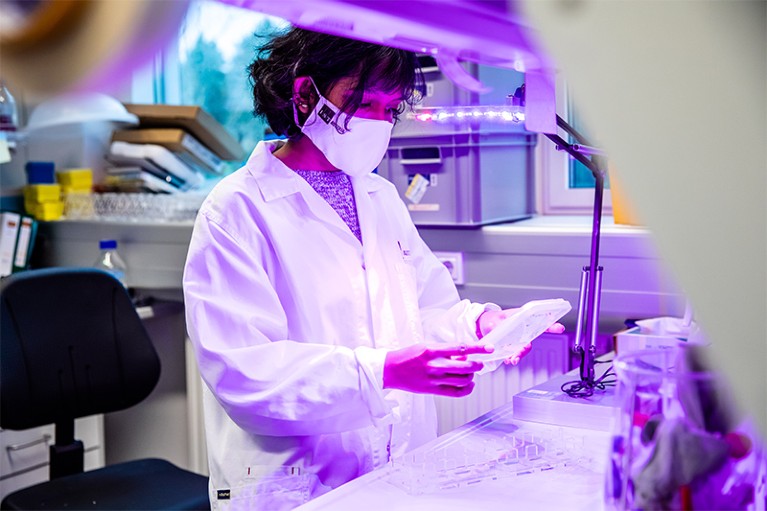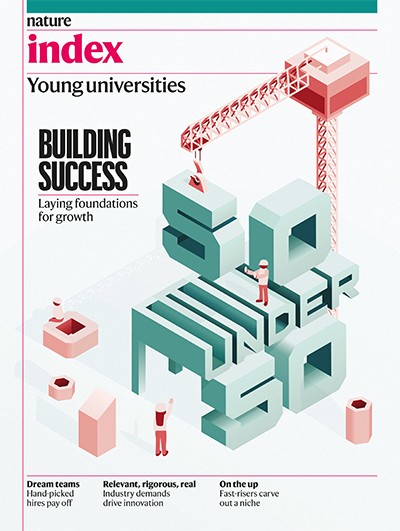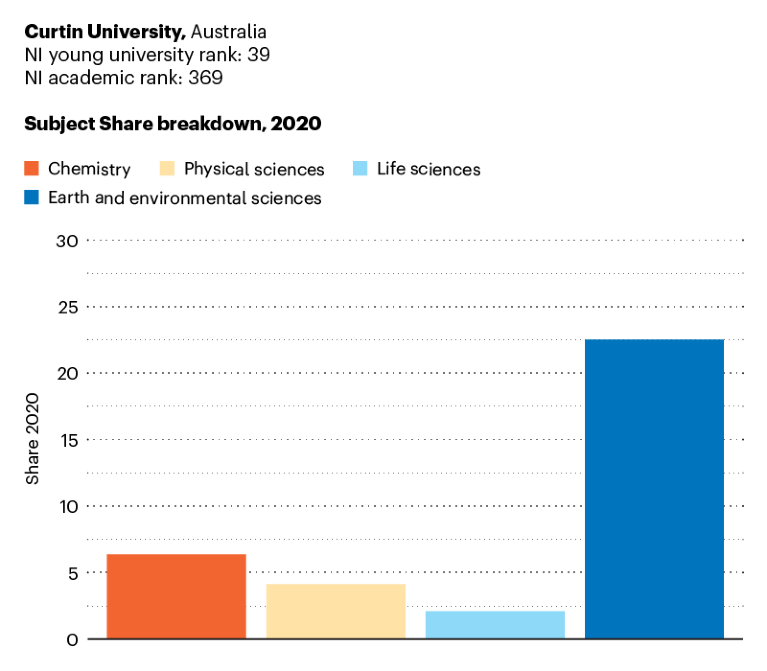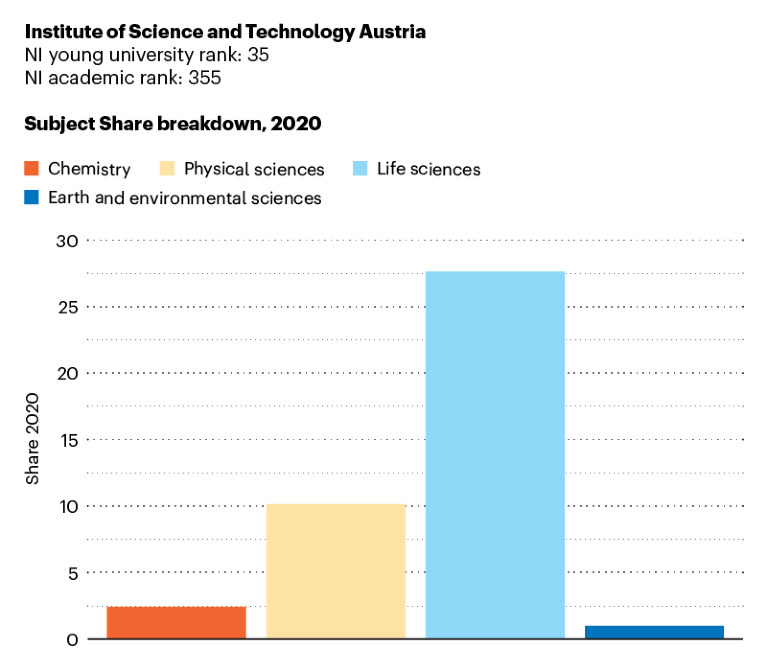
Syamala Inumella, a PhD student from IST Austria’s Benková group, studies plant development.Credit: Nadine Poncioni/IST Austria
Among the Nature Index young universities, these four institutions stand out for their strong performance in a specialized area of research. They have taken divergent paths to success, variously emphasizing close industry ties, an interdisciplinary culture, capacity for innovation, and mentorship.
FRESH AIR: Jawaharlal Nehru Centre for Advanced Scientific Research
With 45 faculty members, the relatively small Jawaharlal Nehru Centre for Advanced Scientific Research (JNCASR), located about 10 kilometres from the much bigger Indian Institute of Science in Bangalore, India, punches above its weight. It was the 6th-fastest rising Nature Index young university in 2019 to 2020, ranked 14th in chemistry and in 30th position for young universities overall. Chemistry contributed nearly four-fifths of its 2020 output, as measured by Share, Nature Index’s signature metric.
Nature Index 2021 Young universities
According to the university’s dean of research and development, K. R. Sreenivas, its founding goal from 1989 was to turbocharge advancement in a few chosen areas by gathering together some of India’s top scientists. Among them was the prolific materials chemist, C. N. R. Rao, who was named its first director. Rao, a pioneer in transition metal oxides and superconductivity research, who has since moved into nanotechnology over a 50-year career, “placed a lot of emphasis on chemistry, in terms of materials research, theory and modelling”, says Sreenivas.
The staff has built up slowly, at a rate of one or two people a year since 1997. “We look for people who are working in new areas, who can bring complementary expertise to our group,” says Sreenivas. Recent hires, for example, have been in battery technology research, leveraging the institute’s strength in materials science, he says.
The nature of the enterprise also fosters collaboration, says Sreenivas. “It’s a small place so we keep bumping into each other, helping to forge alliances across the departments and across the groups.” It also means that collaborations can come together quickly, he says. For example, when India experienced an oxygen shortage during the COVID-19 pandemic, JNCASR mechanical engineers and materials scientists teamed up to develop, within three months, an oxygen-producing device suited to remote primary health centres. — by Flynn Murphy
WEALTH OF KNOWLEDGE: Curtin University
Curtin University in Perth, Australia, achieved university status in 1986, but it began at the Kalgoorlie School of Mines, an applied geosciences college founded in 1902 during a local gold rush, explains Chris Moran, deputy vice-chancellor for research.
“You could say it’s in our veins, because we live in a resources state,” Moran says, referring to Western Australia, which now supplies about two-fifths of the world’s iron ore.
It’s rich in other minerals too, such as the copper, nickel and lithium used in batteries that store energy from renewable sources. Multinational miners BHP, Rio Tinto and Fortescue Metals Group (FMG) have operations there and strong ties to Curtin, about which Moran is unapologetic.
Commercial links are an advantage, he says. “If you’re not on an academic track for your whole career, some people think you’ve failed as a researcher. We don’t think that’s the right outlook.”
These links get researchers the kind of experience they would not get elsewhere, he says. They also provide feedback into scientific questions that might not otherwise be asked.

Source: Nature Index
As the possibility of mining other planets looms closer to reality, the Curtin Space Science and Technology Centre is investigating whether water on the Moon could be used to support missions deeper into space.
The centre mounted its first successful satellite mission in 2021, a multidisciplinary collaboration led by Curtin geologist, Phil Bland, with the Japanese space agency JAXA and American aerospace manufacturer SpaceX. The goal is to have a spacecraft on the Moon by 2025. “You need water, so you can use the Moon as a pit stop,” says Moran. “The Moon’s low gravity means you can get on and off without huge fuel cost. You wouldn’t necessarily think that doing a satellite mission was geoscience. But it’s all about gaining information about Earth and other Solar System bodies for geoscience.” — Flynn Murphy
TAKING ROOT: Institute of Science and Technology Austria
Using a microscope with a vertical stage, Eva Benková, a plant developmental biologist and dean of the graduate school at the Institute of Science and Technology Austria (IST Austria) in Klosterneuburg, can observe plant roots as they grow in real time under gravity. The vertical confocal microscope (one that uses a spatial pinhole to eliminate out-of-focus light) was developed at the bioimaging facility at IST Austria to accommodate Benková and her collaborators’ needs, allowing them to study cell division and expansion in the roots under different environmental conditions. Results were published in The EMBO Journal in January (K. Ötvös et al. EMBO J. 40, e106862; 2021).
Bioimaging is an area of strength for IST Austria, a research institute established in 2009 with a focus on curiosity-driven, basic research. The institute is ranked 35th among the young universities in the Nature Index and is also the 4th-highest ranked young university in the life sciences.
Infrastructure, including for cryo-electron microscopy, supercomputing and 3D printing, is housed in central facilities, says Simon Hippenmeyer, neuroscientist and chair of life sciences. Interdisciplinary collaboration, a defining factor for the institute, is greatly catalysed by the central facilities, he says, noting that there are no departments.

Source: Nature Index
For the past ten years, Hippenmeyer and his collaborators have been combining neuroscience, genetics and cell developmental biology to use and optimize a high-resolution, single-cell labelling technology in mice called MADM (mosaic analysis with double markers). The technology, which allows the researchers to study genetic mutations in individual cells, can be applied to research on cancer and brain-development disorders.
IST Austria recently secured €3.3 billion (US$3.82 billion) of government funding to expand its 67 research groups to 150 by 2036. The new funding will build new labs and facilitate the institute’s expansion into the areas of science education and technology transfer. — by Anthea Lacchia
PASSING THE BATON: Korea Advanced Institute of Science and Technology
The Korea Advanced Institute of Science and Technology (KAIST) in Daejeon, South Korea, turned 50 this year, so has had more time than most of its peers to notch up achievements in the Nature Index: fourth overall among young universities, second for physical sciences, fourth for chemistry and fifth for life sciences.
But, beyond the labs focused on optics, high-energy physics and condensed matter, the age of the university’s senior staff is on the mind of Sang Yup Lee, vice-president of research and distinguished professor of chemical and biomolecular engineering. “South Korea has a mandatory retirement age of 65 for professors,” says Lee. “If some distinguished professor who is a world-leading scientist gets to that age, they retire, and their lab just disappears on the day of retirement. It’s a waste of wisdom.”
KAIST’s solution is what Lee calls cross-generation collaborative laboratories. A senior professor is paired with a younger researcher, and the junior is supported to “quickly absorb all the wisdom, and then take over the lab and continue the legacy”, says Lee.
Finding junior researchers willing to take on the challenge has been tough, he says: so far, the university has six such labs, but the plan is to add more.
Along with a focus on multidisciplinary collaboration and innovation, Lee hopes these cross-generation labs will help set the institution in good stead for the next 50 years. “South Korea does not have many natural resources,” he says. “So we rely on humans.”
The way he sees it, with around one-quarter of researchers at the South Korean multinational corporation Samsung Electronics being graduates of KAIST, and alumni making up one-fifth of the nation’s academics, the university has accomplished its founding mission: to industrialize the country. “Around 50 years ago, South Korea was one of the poorest countries in the world,” he says. “Now we are the number ten economy.” — Flynn Murphy

 Universities under 50 chart a clear roadmap for the future
Universities under 50 chart a clear roadmap for the future
 Young universities forge new paths to success
Young universities forge new paths to success
 Research outliers among universities under 50
Research outliers among universities under 50
 Customized recruitment attracts top talent
Customized recruitment attracts top talent
 Industry demand drives innovation
Industry demand drives innovation








